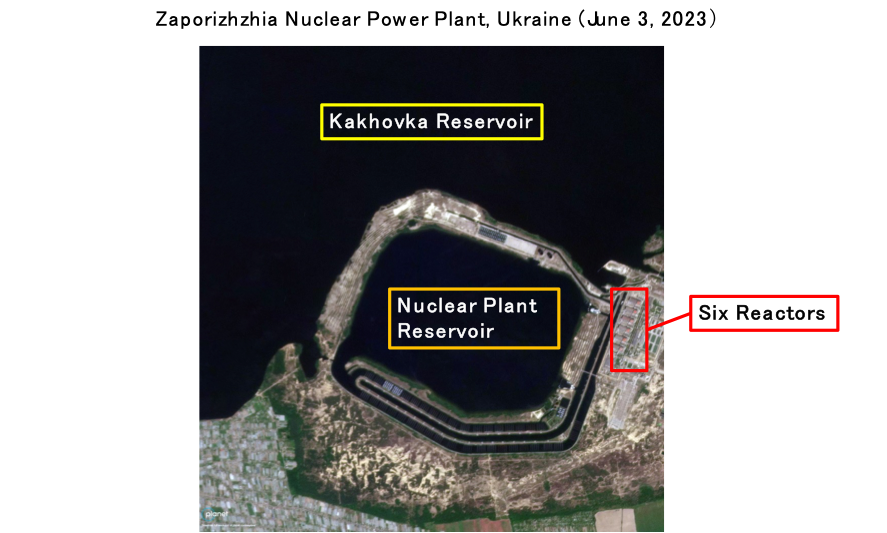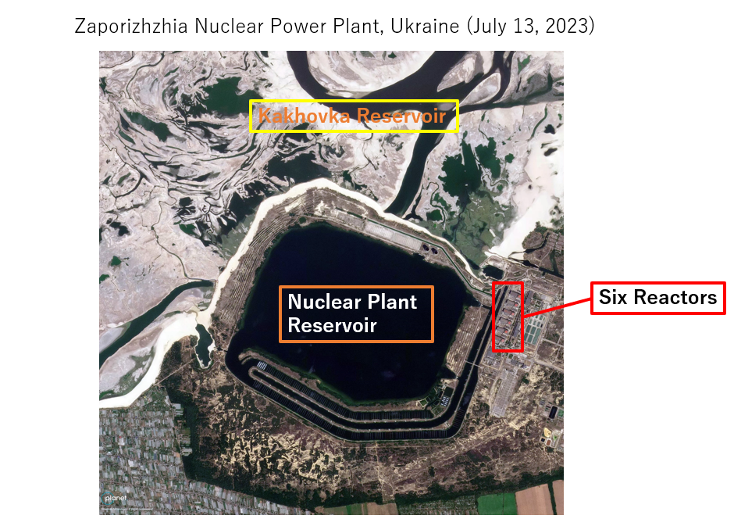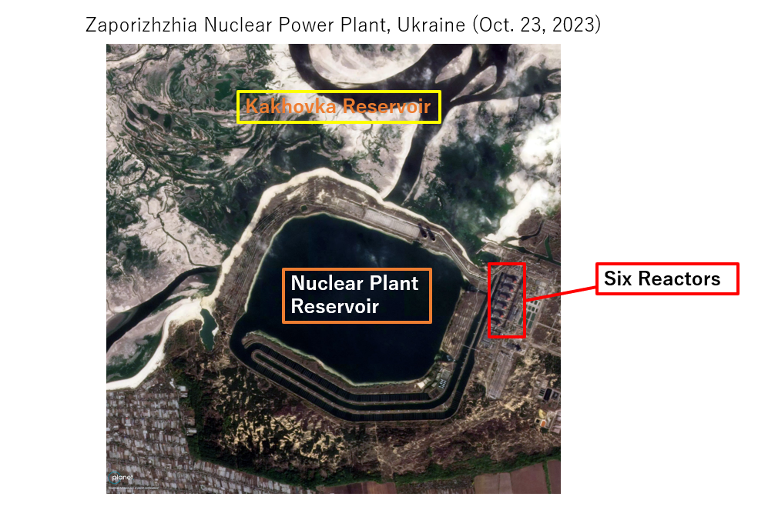Satellite Imagery Analysis 2023/11/30
Special Contribution: Securing Coolant Becomes Problem at Zaporizhzhia Nuclear Power Plant 18 Months after Seizure
Yuki Kobayashi (Research Fellow, Sasakawa Peace Foundation)
Eighteen months have passed since the Zaporizhzhia Nuclear Power Plant in southeastern Ukraine, the nuclear plant with the top power generation capacity in Europe, was captured by the Russian forces. In August and September 2022, there were bombings around the nuclear plant, which both Ukraine and Russia blamed on the other side, giving rise to concerns about massive leakage of radioactive substances caused by damages in the reactors and spent fuel. However, there is now another problem. In June 2023, the Kakhovka Dam located in the lower reaches of the Dnieper-Kakhovka Reservoir, which is the source of cooling water for the nuclear reactors, was breached. Subsequently, the reservoir was found to have dried up. At about this time, the reactors at Zaporizhzhia have frequently reached temperatures above 100oC. While high temperatures in the reactors may not necessarily lead to any immediate danger, the discontinuation of cooling water injection leads to the evaporation of water in the reactors, causing the nuclear fuel to stick out from the water surface, which may activate a meltdown from its own heat.
What is the situation at the nuclear plant’s reservoir today, five months after the destruction of the dam? Is the condition of high temperatures in the reactors related to the condition of the reservoir? At Sasakawa Peace Foundation, we examined the situation at the nuclear plant using newly acquired satellite images and reports by the International Atomic Energy Agency (IAEA).
There are six Russian pressurized water reactors called VVERs operating at the Zaporizhzhia NPP. In the reactors, power is generated by sending high-temperature, high-pressure water produced by heat generated with nuclear fuel to the steam generator, which produces steam fed to the turbines. While the VVER was developed by the former Soviet Union, the ones used at Zaporizhzhia are third generation VVERs, which have containment vessels protecting the reactors, thus ensuring a level of safety comparable to that of Western technologies. Each of the six reactors has the capacity to generate 1,000 MWe (megawatt) of electricity, making a total capacity of 6,000 MWe. This capacity ranks third in the world, after TEPCO’s Kashiwazaki-Kariwa Nuclear Plant (total capacity of 8,212 MWe for its seven reactors) and one other nuclear facility. Until the start of the Russian military invasion on Feb. 24, 2022, Zaporizhzhia NPP accounted for 20% of power supply in Ukraine. On Sept. 11, 2022, its No. 6 Reactor, the only one left running after the seizure, was shut down for security reasons, ending the operation of all reactors.
Temperature remains high for some time and massive amounts of heat continue to be produced inside nuclear power generation facilities even if reactors are shut down and nuclear fission of the fuel is stopped. Therefore, it is necessary to inject water into the reactors to cool the nuclear fuel. This means that water source is vital for nuclear plants.
However, the destruction of the Kakhovka Dam in the lower reaches of the water source in the Russian-occupied area on June 6, 2023, is preventing the securing of water source. Ukraine and Russia both accused the other party of sabotage, but it is reckoned that the breach was caused by explosives placed by the Russian side to obstruct the Ukrainian forces’ counteroffensive.[1] The Dnieper River, which lost its capability to control the flow and amount of water, rushed straight into the Black Sea, and the Kakhovka Reservoir dried up soon after the dam was destroyed. Sasakawa Peace Foundation, in cooperation with Prof. Hidenori Watanave of the University of Tokyo Graduate School, a satellite image analysis expert, compared and analyzed satellite images before and after the dam’s destruction to investigate changes in the [Zaporizhzhia NPP’s] water reservoir and its present condition.

Satellite Image 1
(Source) © Planet Labs. Provided by Hidenori Watanave Laboratory, University of Tokyo Graduate School

Satellite Image 2
(Source) © Planet Labs. Provided by Hidenori Watanabe Laboratory, University of Tokyo Graduate School
Take a look at Satellite Images 1 (taken on June 3, 2023) and 2 (taken on July 13, 2023). The water reservoir located in front of the six nuclear reactors with red round roofs on the grounds of the Zaporizhzhia NPP is part of the Kakhovka Reservoir. It also has port facilities for transporting equipment needed at the nuclear plant. While it would appear that there has not been any significant change in the water level of Zaporizhzhia NPP reservoir, the difference is evident when you look at the reservoir above the reactors outside the grounds of Zaporizhzhia NPP. In Image 1, the reservoir was full, while in Image 2, the reservoir has dried up, and a large area of the reservoir floor can be seen.
Furthermore, Image 3 taken on Oct. 23, 2023, shows that it was becoming difficult for the Zaporizhzhia NPP reservoir to store sufficient water. While in Image 2, one can only see the green portion of the vegetation on the banks of the reservoir, in Image 3, a large white area can be seen under the green portion, meaning water level has dropped compared to July 13 exposing the unvegetated portion of the banks. Since cooling water is circulated between the reservoir and the nuclear reactor buildings, normally, the volume of water does not drop sharply, but there will be a steady decline due to evaporation. Image 3 also shows that the reservoir outside the grounds remains dried up, pointing to the fact that water storage function of the areas near the nuclear plant has not been restored at all after the dam’s destruction. Supply of water to the nuclear plant’s reservoir from the surrounding areas appears to be difficult.

Satellite Image 3
(Source) © Planet Labs. Provided by Hidenori Watanave Laboratory, University of Tokyo Graduate School
Meanwhile, a “hot shutdown condition” of temperatures over 100oC has been observed in several reactors. The IAEA announced on July 29, 2023, that the No. 4 Reactor at the Zaporizhzhia NPP was switched from “cold shutdown” with temperatures under 100 oC in the reactor to “hot shutdown” with temperatures over 100 oC.[2] Subsequently, while Reactor No. 4 returned to cold shutdown, Reactor No. 6 switched to hot shutdown. In October, No. 6 moved back to cold shutdown, but No. 4 switched to hot shutdown again. These were all steps taken by the Russians occupying the nuclear plant.
The “Director General Statement on Situation in Ukraine” updated by IAEA regularly explained that the above situation of temporary hot shutdown of the reactors is because heat emitted by the reactors is used for heat supply in the Zaporizhzhia NPP and the surrounding areas.[3] On the other hand, Ukraine criticized Russia, stating that “Ukrainian safety standards stipulate that cold shutdown is the rule for suspending operation of the Zaporizhzhia reactors. Switching to the dangerous hot shutdown is prohibited.” This is on account of the risk of exposure of nuclear fuel in a short period of time if cooling water fails to be injected due to coolant pump trouble or other problems. For this reason, IAEA proposed setting up external boilers on the Zaporizhzhia NPP grounds instead of hot shutdown of reactors, but setting up the boilers is expected to take until the first half of 2024.[4] This means that for the time being, reactors will continue to take turns switching to hot shutdown.
The statement does not mention the drying up of the Kakhovka Reservoir. At this point, insufficient cooling water due to the drying up of the water source is not considered to be the cause of the hot shutdown, but at least from the analysis of satellite images, there is no doubt that securing cooling water will be a long-term issue for the Zaporizhzhia NPP.
Since the reactors at the nuclear plant have been cooled for nearly one year, stopping the injection of cooling water into the reactors in hot shutdown will not trigger a meltdown immediately. However, it is believed that around seven years of cooling by water is required before the nuclear fuel can reach a temperature level that allows safe transfer to steel containers for air cooling. Just one year is not enough. If failure to inject enough water into the reactors continues, a meltdown will occur eventually. Since a massive amount of hydrogen is generated immediately before a meltdown, which may cause a hydrogen explosion like in the case of the Fukushima Daiichi Nuclear Plant, this may result in the spread of radioactive substances in a wide area.
In which case, contamination will spread to the Crimean Peninsula and the Black Sea, and even Russia cannot avoid the damages. This will have an incalculable impact on the world in terms of food security. A rich black earth region lies in the Dnieper River basin, and central and southern Ukraine have been known as the “granary of Europe” since the 19th Century. Agriculture is the main industry of Ukraine, and it ranks fifth in the world in terms of wheat exports. According to data for 2019 and 2020 from the State Statistics Service of Ukraine, before the Russian invasion, grain accounted for 19% of the country’s exports (worth approx. 49.2 billion dollars). After the invasion, the supply of Ukrainian wheat has been stalled, causing Middle East and African nations to suffer from rising prices of grain. It is highly possible that this situation will remain unchanged.
Two IAEA officials are currently stationed at the Zaporizhzhia NPP. It is hoped that as the watchdog of nuclear energy, IAEA will persist in its work to persuade Russia and Ukraine to understand the potential risks of nuclear power generation and prevent a situation that may affect a wide area, including the neighboring countries. At the same time, Japan and the international community must persevere in persuading Russia and Ukraine regarding the maintenance of the safety of nuclear plants.
1 For example, see “NYT: Evidence Found on Russia Placing Explosives in Kakhovka Dam Destruction,” Reuters, June 18, 2023.
2 IAEA, “Update 176 - IAEA Director General Statement on Situation in Ukraine” July 29, 2023.
3 IAEA, “Update 189 - IAEA Director General Statement on Situation in Ukraine” October 20, 2023.
4 See Note 3.





